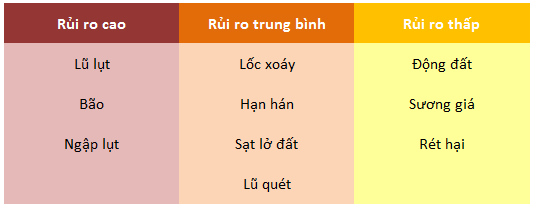Việt Nam là một trong những quốc gia chịu nhiều thiên tai nhất trên thế giới. Đất nước có hình chữ S, bờ biển dài 3.440 km, vị trí địa lý độc đáo nằm trong vành đai gió mùa Đông Nam Á cùng với địa hình đa dạng đồng nghĩa với việc Việt Nam phải hứng chịu nhiều loại hình thiên tai khác nhau như bão, áp thấp nhiệt đới, lũ lụt, hạn hán, xâm nhập mặn, sạt lở đất và cháy rừng. Hơn 70% dân số Việt Nam đang gặp rủi ro do thiên tai, đặc biệt là người nghèo ở nông thôn và thành thị. 1
Thiên tai đã trở thành một phần của cuộc sống ở nơi đây, tuy nhiên biến đổi khí hậu đã tác động mạnh mẽ đến tần suất và mức độ nghiêm trọng của những thảm họa này trên khắp toàn cầu, bao gồm cả Việt Nam.2 Trong ba thập kỷ qua, các hiện tượng thời tiết cực đoan đã cướp đi sinh mạng của 500 người mỗi năm.3 Với phần lớn dân số tập trung sinh sống ở các vùng ven biển hẹp và vùng trũng thấp của đồng bằng ven sông – những khu vực dễ bị ảnh hưởng bởi thiên tai – Việt Nam nằm trong danh sách năm quốc gia có khả năng bị ảnh hưởng nặng nề nhất bởi biến đổi khí hậu.4Những khu vực vùng trũng thấp này từ lâu cũng là nơi rất phù hợp cho sản xuất nông nghiệp và các hoạt động kinh tế quan trọng khác, vì vậy khi thiên tai xảy ra nền kinh tế cũng bị ảnh hưởng nghiêm trọng theo.5 Thiệt hại kinh tế do thiên tai hàng năm lên tới 1% GDP của cả nước.6 Tổng thiệt hại do thiên tai năm 2020 là 1,45 tỷ USD,7 bằng gần một nửa giá trị xuất khẩu gạo năm 2020 của Việt Nam.8
Mặc dù thiên tai, thảm họa không phân biệt đối xử, nhưng những người nghèo sẽ tiếp xúc và bị ảnh hưởng nhiều hơn bởi các tác động của thiên tai. Các nhóm bị ảnh hưởng khác bao gồm phụ nữ và trẻ em gái, những người thường chịu trách nhiệm cho các công việc đồng áng, đi lấy nước cho gia đình và những người dân tộc thiểu số sống.9
Hình 1: Phân loại mức độ rủi ro của các loại hình thiên tai ở Việt Nam10
Các hiểm họa tự nhiên có thể là các hiện tượng khí tượng thủy văn (ví dụ như bão, lũ lụt, mưa lớn và hạn hán) và hiện tượng địa vật lý (ví dụ như sạt lở đất). “Chiến lược quốc gia về phòng chống, ứng phó và giảm nhẹ thiên tai đến năm 2030, tầm nhìn 2050” của Việt Nam năm 2021 đã xác định bão, lũ lụt, hạn hán và xâm nhập mặn là những ưu tiên.
Bảng 1: Tóm tắt các sự kiện thiên tai ở Việt Nam giai đoạn 1990-202111
Hình 2: Bản đồ hiểm họa của các vùng ở Việt Nam12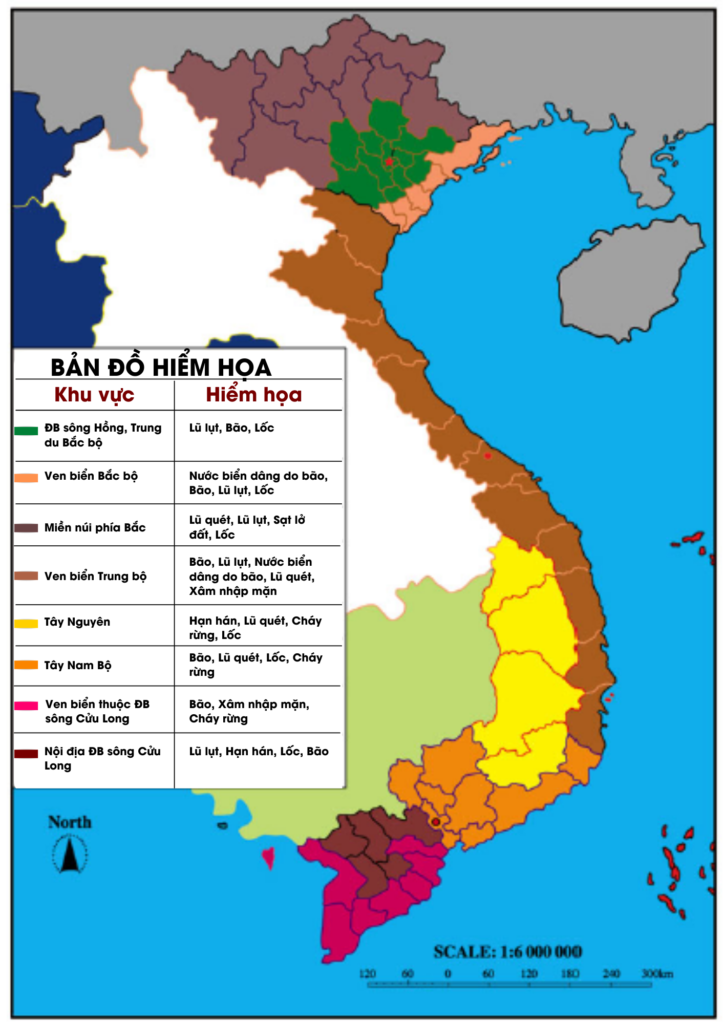
Lũ lụt
Lũ lụt gây ra 97% thiệt hại do thiên tai hàng năm.

Thị trấn Phong Nha – tỉnh Quảng Bình chìm trong lũ lụt 2016. Ảnh chụp bởi Alan & Flora Botting đăng trên Flickr. Được cấp phép theo CC BY-SA 2.0.
Địa lý tự nhiên khiến Việt Nam dễ bị lũ lụt, thường diễn ra trong mùa gió mùa (tháng 6 đến tháng 11) và mùa bão (tháng 7 đến tháng 10) ở vùng trũng thấp đồng bằng sông Hồng (ĐBSH), đồng bằng sông Cửu Long (ĐBSCL) và duyên hải miền Trung.13 Hình thái tự nhiên này đã tạo ra sự đa dạng sinh học và sự phong phú về nông nghiệp cho các khu vực này, tuy nhiên sự gia tăng mức độ nghiêm trọng của bão đã làm tăng rủi ro đối với cuộc sống và sinh kế của người dân.14 Những rủi ro này cộng với sự xói mòn đất dẫn đến khả năng cao xảy ra lũ quét và sạt lở đất làm hư hỏng cơ sở hạ tầng, nhà cửa, thiệt hại về gia súc,15 làm tăng tính dễ bị tổn thương của những người nghèo ở nông thôn vốn đã kém khả năng chống chịu.16 Tại các khu vực đô thị như Hà Nội và thành phố Hồ Chí Minh, tác động của lũ lụt có xu hướng trầm trọng hơn do hệ thống thoát nước kém.17
Hình 3: Địa điểm bị lũ lụt ở Việt Nam18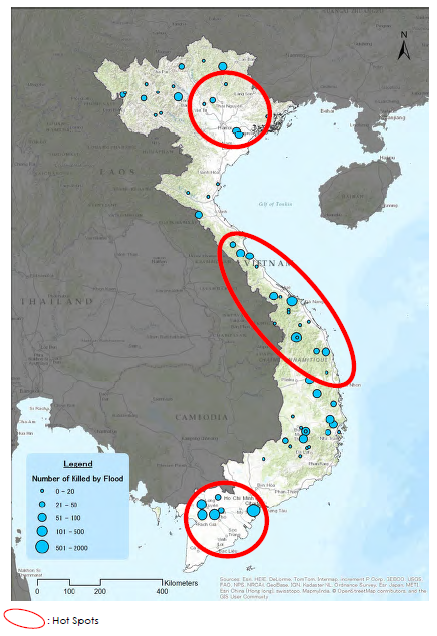
Bão
Do vị trí địa lý, Việt Nam rất dễ hứng chịu các cơn bão, đặc biệt ở khu vực dọc theo bờ biển phía Bắc. Tần suất của bão đã tăng lên từ trung bình 5 lên 7 cơn bão kể từ năm 2000. Bão đổ bộ thường kèm theo triều cường và mưa lớn nên gây ra những đợt mưa to kéo dài và gây ngập lụt nặng nề. Trận “lũ chồng lũ” lịch sử năm 2020 ở miền Trung, do 9 cơn bão lớn và 2 cơn áp thấp nhiệt đới gây ra đã làm 192 người chết và 57 người mất tích. Nhà cửa bị tàn phá nghiêm trọng gây sập và tốc mái; nhà cửa, trường học và cơ sở y tế bị ngập nước. Hơn 49.930 ha lúa và hoa màu bị tàn phá, hàng chục ngàn con gia súc và hàng triệu con gia cầm bị chết hoặc bị nước cuốn trôi.19 Bão đã gây tổn thất kinh tế nghiêm trọng. Thiệt hại do bão trong giai đoạn 1993–2013 là 2,4% GDP trung bình hàng năm.20
Biến đổi khí hậu tương tác với các cơn bão gây nên các nguy cơ như nước dâng do bão. Đây được dự báo là nguyên nhân chính gây ra thiệt hại kinh tế ở Việt Nam trong giai đoạn sau năm 2050.21
Hình 4: Các cơn bão nhiệt đới đổ bộ vào Việt Nam trong giai đoạn 1970-201522
Sạt lở đất
Sạt lở đất thường xảy ra ở khu vực vùng núi phía Bắc Việt Nam, miền Trung gần biên giới với Lào và vùng ven biển. Sạt lở đất thường do mưa lớn khi có bão gây ra.23
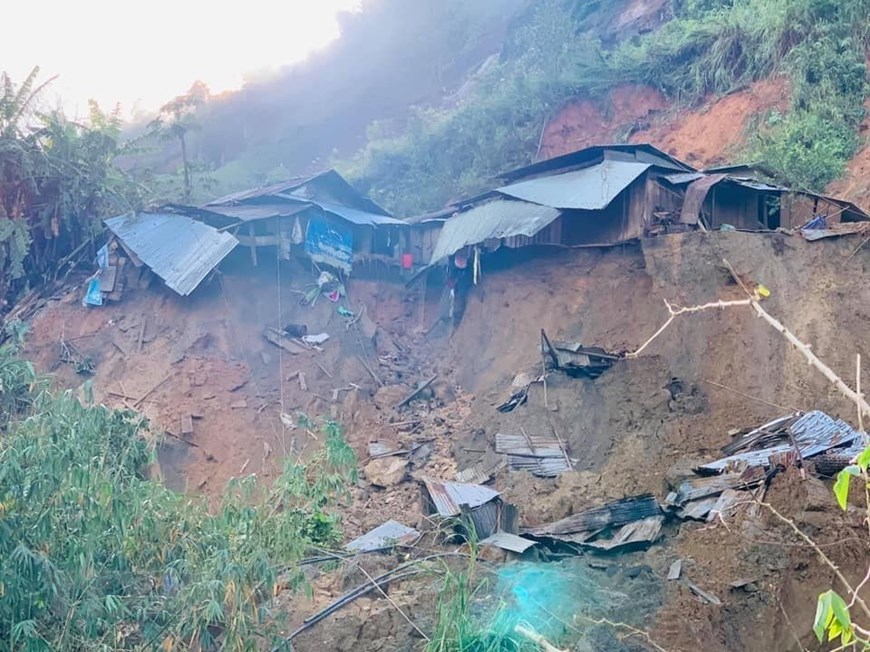
Sạt lở đất ở huyện Phước Sơn, tỉnh Quảng Nam năm 2020. Ảnh chụp bởi Vietnam plus/TTXVN.
Hạn hán và xâm nhập mặn
Mùa khô là một phần của thời tiết tự nhiên ở Việt Nam, khô hạn thỉnh thoảng xảy ra ở khu vực Bắc Trung Bộ và chủ yếu ở Duyên hải Nam Trung Bộ, Tây Nguyên và ĐBSCL. Tuy nhiên, mức độ nghiêm trọng và độ dài của mùa khô hạn đã tăng lên, với các đợt hạn hán nghiêm trọng trong lịch sử đã được ghi nhận ở ĐBSCL trong các năm 2015-2016 và 2019-2020. Có hai loại hạn hán chính ở Việt Nam: (i) hạn hán khí tượng (thường liên quan đến thâm hụt lượng mưa) và (ii) hạn hán thủy văn (thường liên quan đến sự thiếu hụt dòng nước bề mặt và dưới bề mặt, có khả năng bắt nguồn từ các lưu vực sông lớn hơn của khu vực). 24
Tình trạng thiếu nước do hạn hán kết hợp với xâm nhập mặn đã ảnh hưởng đến việc cấp nước và tình hình sản xuất nông nghiệp của ĐBSCL. Khoảng 430.000 người bị thiếu nước sinh hoạt trong đợt hạn hán 2019-2020 và các dịch vụ quan trọng khác như bệnh viện và trường học cũng bị hạn chế do thiếu nước.25 Lúa, cây ăn quả, rau màu và thủy sản cũng chịu tổn thất và thiệt hại nặng nề.26 Tổn thất kinh tế của đợt hạn hán năm 2015-2016 do Cục bảo vệ trồng trọt ước tính là 1,5 tỷ đô la Mỹ.27
Hình 5: Xâm nhập mặn ở đồng bằng sông Cửu Long28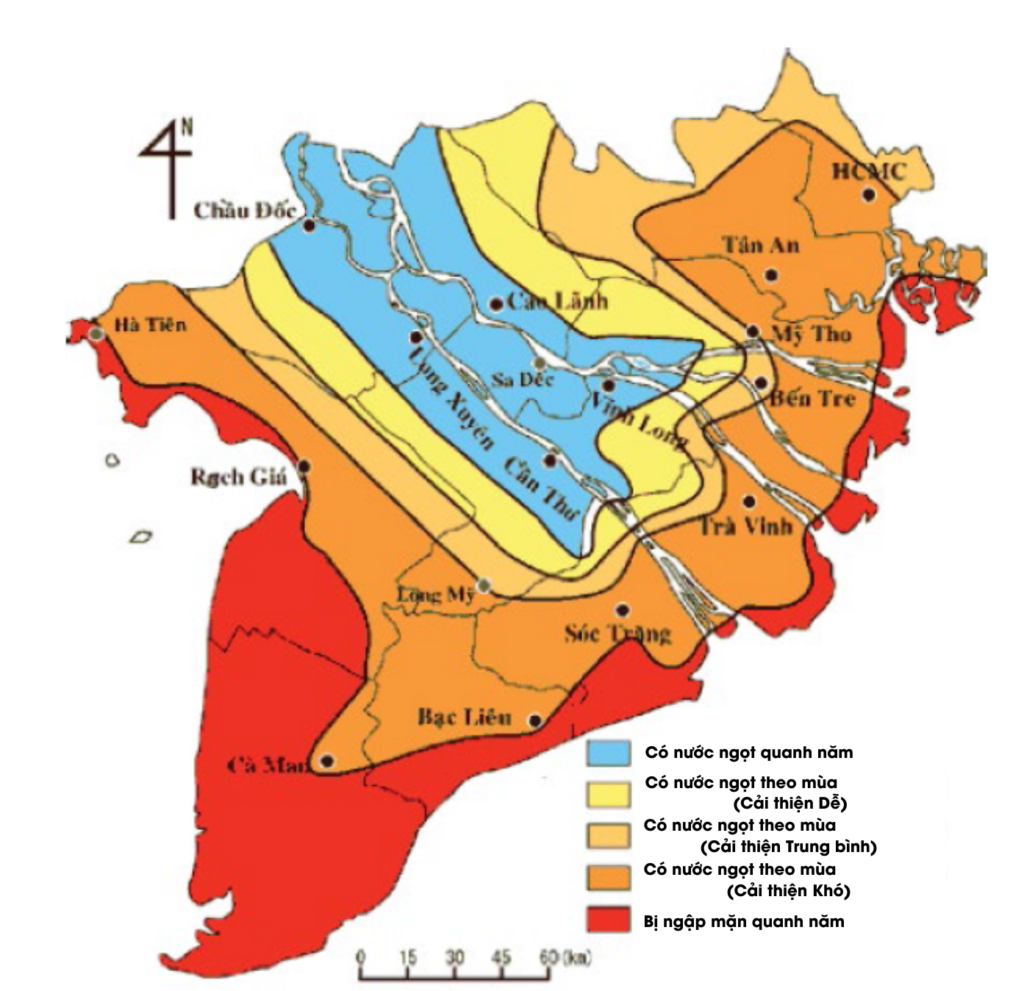
Đồng bằng sông Cửu Long là một trong ba đồng bằng trên thế giới dễ bị tổn thương nhất bởi biến đổi khí hậu và nước biển dâng. Tuy nhiên, các hoạt động của con người ở cả khu vực đồng bằng và phía thượng nguồn cũng gây tác động đến chức năng của sông Mê kông. Các đập thủy điện ở thượng nguồn và việc khai thác cát quá mức là những nguyên nhân chính làm tăng tình trạng xâm nhập mặn. Đồng thời, khai thác nước ngầm quá mức khiến mặt đất dịch chuyển xuống dưới và do đó khiến mực nước biển tương đối dâng cao.29
Dịch bệnh
Việt Nam được xác định là một trong những “điểm nóng” toàn cầu có nguy cơ rất cao xuất hiện các tác nhân gây bệnh truyền nhiễm mới nổi, hoặc các bệnh có tỷ lệ mắc tăng gần đây, bao gồm các bệnh lây truyền từ vật nuôi, động vật hoang dã hoặc hệ sinh thái. Các bệnh truyền nhiễm xuất hiện gần đây như SARS (2003), cúm “gia cầm” (H5N1, 2003), cúm “lợn” (H1N1, 2009) và COVID-19.30
Thiên tai và biến đổi khí hậu ảnh hưởng đến tỷ lệ bùng phát bệnh truyền nhiễm do những thay đổi của môi trường, điều kiện con người và tính dễ bị tổn thương đối với các mầm bệnh hiện có.31
Phòng chống và giảm nhẹ thiên tai và biến đổi khí hậu
Chính phủ Việt Nam đã sớm nhận thức được tầm quan trọng của việc xây dựng năng lực chống chịu với các hiểm họa thiên nhiên và giảm thiểu tác động của biến đổi khí hậu từ nhiều thập kỷ nay. Chuyển từ cứu trợ và ứng phó với thiên tai sang chủ động giảm thiểu rủi ro, Chiến lược quốc gia về phòng chống, ứng phó và giảm nhẹ thiên tai đến năm 2020 đã được phê duyệt năm 2007, bản chiến lược mới đến 2030 – tầm nhìn 2050 cũng mới được thông qua năm 2021. Ngoài ra, Chính phủ đã ban hành Chiến lược quốc gia về biến đổi khí hậu (2011–2020) vào năm 2011 và Kế hoạch thích ứng quốc gia (2020–2030) vào năm 2018. Chương trình quốc gia hỗ trợ quản lý rủi ro thiên tai dựa vào cộng đồng cũng được thực hiện.32
Tuy nhiên, các chính sách, kế hoạch và việc đầu tư cho quản lý rủi ro thiên tai và thích ứng với biến đổi khí hậu của Việt Nam còn rời rạc và chưa được lồng ghép một cách nhất quán hay hiệu quả vào lập kế hoạch.33 Mặc dù đã có những nỗ lực để cải thiện hệ thống, các hành động mang tính phản ứng ngắn hạn thường được thực hiện theo sự vụ chứ nhiều hơn là các chiến lược có tính chủ động,, chỉ có một số ít hành động giải quyết vấn đề cốt lõi dẫn đến tình trạng dễ bị tổn thương.34
Việt Nam có kế hoạch cải thiện tính nhất quán của toàn bộ môi trường pháp lý, chính sách và tài chính liên quan đến quản lý rủi ro thiên tai và biến đổi khí hậu.35
References
- 1. OCHA.2021. Lồng ghép khả năng chống chịu với thiên tai ở Việt Nam: kết hợp với cộng đồng để xây dựng khả năng chống chịu. Truy cập tháng 11, 2021
- 2. IFRC. 2020. Báo cáo thảm họa thế giới: Nóng lên hoặc Nước dâng cao. Truy cập tháng 11, 2021
- 3. CRED.2021. Dữ liệu về thảm họa thế giới – EMDAT data. Truy cập tháng 11, 2021
- 4. Ngân hàng Thế giới; Ngân hàng phát triển Châu Á. 2021. Hồ sơ quốc gia về rủi ro khí hậu: Việt Nam. Truy cập tháng 11, 2021
- 5. Ibid
- 6. CRED.2021. Dữ liệu về thảm họa thế giới – EMDAT data. Truy cập tháng 11, 2021
- 7. Ibid
- 8. Bộ NN&PTNT .2020. Dấu ấn của gạo Việt Nam. Truy cập tháng 11, 2021
- 9. GFDRR. 2017. Hướng tới quản lý rủi ro thiên tai ở Việt Nam: Khuyến nghị dựa trên Khủng hoảng xâm nhập mặn và hạn hán và trường hợp đầu tư vào khả năng chống chịu lâu dài. Truy cập tháng 11, 2021.
- 10. JICA.2015. Báo cáo quốc gia Việt Nam: Đánh giá rủi ro thiên tai và Xây dựng kế hoạch liên tục kinh doanh cho các khu công nghiệp tổng hợp trong khu vực ASEAN. Truy cập tháng 11, 2021.
- 11. CRED.2021. Dữ liệu về thảm họa thế giới – EMDAT data. Truy cập tháng 11, 2021
- 12. Chính phủ Việt Nam. 2005. Báo cáo quốc gia về giảm nhẹ thiên tai ở Việt Nam – Cho Hội nghị thế giới về giảm nhẹ thiên tai, Kobe-Hyogo, Nhật Bản, 18-22 tháng 1 năm 2005. Accessed November, 2021.
- 13. JICA.2015. Báo cáo quốc gia Việt Nam: Đánh giá rủi ro thiên tai và Xây dựng kế hoạch liên tục kinh doanh cho các khu công nghiệp tổng hợp trong khu vực ASEAN. Truy cập tháng 11, 2021.
- 14. GIZ.2018. Khả năng thích ứng với khí hậu ở Việt Nam: Đánh giá ở các vùng đô thị.Truy cập tháng 11, 2021
- 15. Ibid
- 16. OCHA.2021. Lồng ghép khả năng chống chịu với thiên tai ở Việt Nam: kết hợp với cộng đồng để xây dựng khả năng chống chịu. Truy cập tháng 11, 2021
- 17. GIZ.2018. Khả năng thích ứng với khí hậu ở Việt Nam: Đánh giá ở các vùng đô thị. Truy cập tháng 11, 2021.
- 18. JICA.2015. Báo cáo quốc gia Việt Nam: Đánh giá rủi ro thiên tai và Xây dựng kế hoạch liên tục kinh doanh cho các khu công nghiệp tổng hợp trong khu vực ASEAN. Truy cập tháng 11, 2021.
- 19. Tạp chí điện tử Đầu tư tài chính. 2020. Thiên tai dị thường ở miền Trung gây thiệt hại kinh tế 30.000 tỷ đồng. Truy cập tháng 12, 2021.
- 20. Espagne E. (ed.), T. Ngo-Duc, M-H. Nguyen, E. Pannier, M-N. Woillez, A. Drogoul, T. P. L. Huynh, T. T. Le, T. T. H. Nguyen, T. T. Nguyen, T. A. Nguyen, F. Thomas, C. Q. Truong, Q. T. Vo, C. T. Vu. 2021. Biến đổi khí hậu ở Việt Nam: Tác động và thích ứng. Báo cáo đánh giá phục vụ COP26 của dự án GEMMES Việt Nam. Truy cập tháng 12, 2021.
- 21. Ngân hàng Thế giới; Ngân hàng phát triển Châu Á. 2021. Hồ sơ quốc gia về rủi ro khí hậu: Việt Nam. Truy cập tháng 11, 2021
- 22. UNEP/GRID-Geneva. 2021. Nền tảng dữ liệu về rủi ro toàn cầu. Truy cập tháng 11, 2021
- 23. JICA.2015. Báo cáo quốc gia Việt Nam: Đánh giá rủi ro thiên tai và Xây dựng kế hoạch liên tục kinh doanh cho các khu công nghiệp tổng hợp trong khu vực ASEAN. Truy cập tháng 11, 2021.
- 24. Ngân hàng Thế giới; Ngân hàng phát triển Châu Á. 2021. Hồ sơ quốc gia về rủi ro khí hậu: Việt Nam. Truy cập tháng 11, 2021
- 25. Bộ NN&PTNT. 2020.Vượt qua mùa hạn mặn nhất lịch sử, những bài học cho hiện tại, tương lai. Truy cập tháng 12, 2021.
- 26. Ibid
- 27. GIZ.2018. Khả năng thích ứng với khí hậu ở Việt Nam: Đánh giá ở các vùng đô thị.Truy cập tháng 11, 2021.
- 28. Ibid
- 29. Espagne E. (ed.), T. Ngo-Duc, M-H. Nguyen, E. Pannier, M-N. Woillez, A. Drogoul, T. P. L. Huynh, T. T. Le, T. T. H. Nguyen, T. T. Nguyen, T. A. Nguyen, F. Thomas, C. Q. Truong, Q. T. Vo, C. T. Vu. 2021. Biến đổi khí hậu ở Việt Nam: Tác động và thích ứng. Báo cáo đánh giá phục vụ COP26 của dự án GEMMES Việt Nam. Truy cập tháng 12, 2021.
- 30. Cục Y tế dự phòng. 2021.70% các bệnh truyền nhiễm mới nổi trên người ở Việt Nam có nguồn gốc từ động vật. Truy cập tháng 11, 2021.
- 31. Isidore K Kouadio, Syed Aljunid, Taro Kamigaki, Karen Hammad & Hitoshi Oshitani.2012. Các bệnh truyền nhiễm sau thiên tai: các biện pháp phòng, chống.Truy cập tháng 12, 2021.
- 32. GFDRR.2016. Hồ sơ quốc gia: Việt Nam. Truy cập tháng 11, 2021
- 33. GFDRR. 2017. Hướng tới quản lý rủi ro thiên tai ở Việt Nam: Khuyến nghị dựa trên Khủng hoảng xâm nhập mặn và hạn hán và trường hợp đầu tư vào khả năng chống chịu lâu dài. Truy cập tháng 11, 2021.
- 34. Espagne E. (ed.), T. Ngo-Duc, M-H. Nguyen, E. Pannier, M-N. Woillez, A. Drogoul, T. P. L. Huynh, T. T. Le, T. T. H. Nguyen, T. T. Nguyen, T. A. Nguyen, F. Thomas, C. Q. Truong, Q. T. Vo, C. T. Vu. 2021. Biến đổi khí hậu ở Việt Nam: Tác động và thích ứng. Báo cáo đánh giá phục vụ COP26 của dự án GEMMES Việt Nam. Truy cập tháng 12, 2021.
- 35. GFDRR. 2017. Hướng tới quản lý rủi ro thiên tai ở Việt Nam: Khuyến nghị dựa trên Khủng hoảng xâm nhập mặn và hạn hán và trường hợp đầu tư vào khả năng chống chịu lâu dài. Truy cập tháng 11, 2021.
